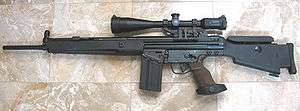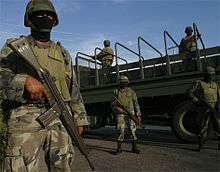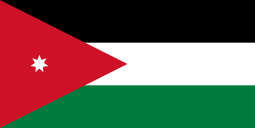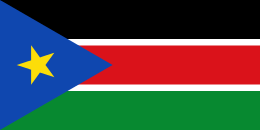Heckler & Koch G3
| Heckler & Koch G3 | |
|---|---|
|
The G3A4 (top) and G3A3 (bottom) | |
| Type | Battle rifle |
| Place of origin | West Germany |
| Service history | |
| In service | 1959–present |
| Used by | See Users |
| Wars |
Portuguese Colonial War Carnation Revolution Yemeni Civil War (2015-present)[1] Saudi-led intervention in Yemen (2015-present) Conflict in Najran, Jizan and Asir |
| Production history | |
| Designer |
CETME Mauser Heckler & Koch |
| Designed | 1950s |
| Manufacturer |
Heckler & Koch (original) Rheinmetall MIC SEDENA Defense Industries Organization Fábrica de Braço de Prata Bofors Carl Gustaf Husqvarna Vapenfabriks Aktiebolag Elliniki Viomihania Oplon Kongsberg Våpenfabrikk MAS Military Industry Corporation MKEK Pakistan Ordnance Factories Royal Ordnance Bangladesh Ordnance Factories |
| Produced | 1958–present |
| No. built | 7,000,000[2] |
| Variants | See Variants |
| Specifications | |
| Weight |
4.1 kg (9.04 lb) (G3A3) 4.7 kg (10 lb) (G3A4) 5.54 kg (12.2 lb) with optic (G3SG/1) 4.1 kg (9.0 lb) (G3K) |
| Length |
1,025 mm (40.4 in) (G3A3) 1,025 mm (40.4 in) stock extended / 840 mm (33.1 in) stock collapsed (G3A4) 1,025 mm (40.4 in) (G3SG/1) 895 mm (35.2 in) stock extended / 711 mm (28.0 in) stock collapsed (G3K) |
| Barrel length |
450 mm (17.7 in) 315 mm (12.4 in) (G3K) |
|
| |
| Cartridge | 7.62×51mm NATO |
| Action | Roller-delayed blowback |
| Rate of fire | 500–600 rounds/min |
| Muzzle velocity | 800 m/s (2,625 ft/s) |
| Effective firing range | 500 metres (550 yd), 100–400 m sight adjustments |
| Feed system | 20-round detachable box 30-round detachable box and 50-round drum magazine |
| Sights | Rear: rotary diopter; front: hooded post |
The G3 is a 7.62×51mm NATO battle rifle developed in the 1950s by the German armament manufacturer Heckler & Koch GmbH (H&K) in collaboration with the Spanish state-owned design and development agency CETME (Centro de Estudios Técnicos de Materiales Especiales).[3]
History


The origin of this rifle can be traced back to the final years of World War II when Mauser engineers at the Light Weapon Development Group (Abteilung 37) at Oberndorf am Neckar designed the MKb Gerät 06 (Maschinenkarabiner Gerät 06 or "machine carbine device 06") prototype assault rifle chambered for the intermediate 7.92×33mm Kurz cartridge, first with the Gerät 06 model using a roller-locked short recoil mechanism originally adapted from the MG 42 machine gun but with a fixed barrel and conventional gas-actuated piston rod.[4] It was realized that with careful attention to the mechanical ratios, the gas system could be omitted.[5] The resultant weapon, the Gerät 06H (the "H" suffix is an abbreviation for halbverriegelt or "half-locked") was assigned the designation StG 45(M) (Sturmgewehr 45(M) or assault rifle) but was not produced in any significant numbers and the war ended before the first production rifles were completed.[6]
The German technicians involved in developing the StG 45(M) were taken to work in France at CEAM (Centre d'Etudes et d'Armement de Mulhouse). The StG 45(M) mechanism was modified by Ludwig Vorgrimler and Theodor Löffler at the Mulhouse facility between 1946 and 1949. Three versions were made, chambered in .30 Carbine, 7.92×33 mm Kurz as well as the experimental 7.65×35 mm French short cartridge developed by Cartoucherie de Valence in 1948. A 7.5×38 mm cartridge using a partial aluminium bullet was abandoned in 1947. Löffler's design, designated the Carabine Mitrailleuse Modèle 1950, was retained for trials among 12 different prototypes designed by CEAM, MAC, and MAS. Engaged in the Indochina War and being the second NATO contributor, France canceled the adoption of these new weapons for financial reasons.
In 1950, Vorgrimler moved to Spain where he created the LV-50 rifle chambered for the Kurz cartridge and later, the proprietary 7.92×40mm CETME M53 round.[7] At this point, the rifle was renamed the Modelo 2. The Modelo 2 drew the attention of the West German Border Guards (Bundesgrenzschutz), who sought to re-equip the newly formed national defense forces. Not willing to accept a cartridge outside of the NATO specification, the Germans asked CETME to develop a 7.62×51mm version of the rifle. The resulting CETME Model A was chambered for the 7.62×51mm CETME cartridge which was identical in chamber dimensions but had a reduced-power load compared to the 7.62×51mm NATO round. Further development of the rifle with input from H&K produced the CETME Model B which received several modifications, including the ability to fire from a closed bolt in both semi-automatic and automatic firing modes, a new perforated sheet metal handguard (the folding bipod had been the foregrip in previous models), improved ergonomics and a slightly longer barrel with a 22 mm rifle grenade launcher guide. In 1958, this rifle was accepted into service with the Spanish Army as the Modelo 58, using the 7.62×51mm CETME round.
In 1956, the Bundesgrenzschutz canceled their planned procurement of the CETME rifles, adopting the Belgian-made FN FAL (G1) instead. However, the newly formed West German Army (Bundeswehr) now showed interest and soon purchased a number of CETME rifles (7.62×51mm NATO chambering) for further testing. The CETME, known as the Automatisches Gewehr G3 according to German nomenclature, competed successfully against the Swiss SIG SG 510 (G2) and the American AR-10 (G4) to replace the previously favored G1 rifle. In January 1959, the Bundeswehr officially adopted the CETME proposal. The West German government wanted the G3 rifle to be produced under license in Germany; purchase of the G1 had previously fallen through over FN's refusal to grant such a license. In the case of the G3, the Dutch firm Nederlandse Wapen en Munitiefabriek (NWM) held production and sales rights to the CETME design outside of Spain. To acquire production rights, the West German government offered NWM contracts to supply the German Air Force (Luftwaffe) with 20mm ammunition. Production of the G3 was then assigned to Rheinmetall and H&K. The latter company already had ties to CETME, and had worked to further optimize the CETME rifle for use with the full-power 7.62×51mm NATO cartridge (as opposed to the downgraded CETME variant). In 1969, Rheinmetall gave up production rights to the G3 in exchange for H&K's promise not to bid on MG 3 production. Later in 1977, the West German government ceded ownership of G3 production and sales rights exclusively to H&K.
Initial production G3 rifles differed substantially from more recent models; early rifles featured closed-type mechanical flip-up sights (with two apertures), a lightweight folding bipod, a stamped sheet steel handguard, a wooden buttstock (in fixed stock models) or a telescopic metal stock.[7] The weapon was modernized during its service life (among other minor modifications it received new sights, a different flash suppressor, and a synthetic handguard and shoulder stock), resulting in the most recent production models, the G3A3 (with a fixed polymer stock) and the G3A4 (telescoping metal stock). The rifle proved successful in the export market, being adopted by the armed forces of over 40 countries.[7] Of that figure, 18 countries undertook domestic production of the G3 under license.[8] Known manufacturers of the weapon included: France (MAS), Greece (Hellenic Arms Industry), Iran (Defense Industries Organization), Luxembourg (Luxemburg Defense Technologie), Mexico, Myanmar, Norway (Kongsberg Våpenfabrikk), Pakistan (Pakistan Ordnance Factories), Portugal (FBP), Saudi Arabia, Sweden (FFV), Thailand, Turkey (MKEK) and the United Kingdom (Royal Ordnance).[7]
Design details

The G3A3 (A4) is a selective-fire automatic weapon that employs a roller-delayed blowback operating system. The two-piece bolt assembly consists of a breech (bolt head) and bolt carrier. The bolt is held in battery by two sliding cylindrical rollers that engage locking recesses in the barrel extension. The breech is opened when both rollers are compressed inward against camming surfaces driven by the rearward pressure of the expanding gases upon the bolt head. As the rollers move inward, recoil energy is transferred to the locking piece and bolt carrier which begin to withdraw while the bolt head slowly moves rearward in relation to the bolt carrier. As the bolt carrier clears the rollers, pressure in the bore drops to a safe level, the bolt head is caught by the bolt carrier and moves to the rear as one unit, continuing the operating cycle. The bolt also features an anti-bounce mechanism that prevents the bolt from bouncing off the barrel's breech surface. The spring-powered claw extractor is also contained inside the bolt while the lever ejector is located inside the trigger housing (actuated by the recoiling bolt).[7]
The rifle is hammer fired and has a trigger mechanism with a 3-position fire selector switch that is also the manual safety toggle that secures the weapon from accidentally discharging (fire selector in the "E" or "1" position – single fire mode ("Einzelfeuer"), "F" or "20" – automatic fire ("Feuerstoß"), "S" or "0" – weapon is safe ("Sicher"), trigger disabled mechanically). The weapon can be fitted with an optional 4-position safety/fire selector group illustrated with pictograms with an ambidextrous selector lever. The additional, fourth selector setting enables a 3-round burst mode of fire.[7]
The firearm is equipped with iron sights that consist of a rotary rear drum and hooded front post. The rear sight, mechanically adjustable for both windage and elevation, has an open notch used to fire up to 100 m and three apertures used for: 200, 300 and 400 m.[7] The receiver housing has recesses that work with HK clamp adapters used to mount day or night optics.
The rifled barrel (contains 4 right-hand grooves with a 305 mm twist rate) terminates with a slotted flash suppressor which can also be used to attach a bayonet or serve as an adapter for launching rifle grenades. From the G3A3 the barrel had polygonal rifling.[9] The barrel chamber is fluted, which assists in the initial extraction of a spent cartridge casing (since the breech is opened under very high barrel pressure).[7]
The G3A3 (A4) uses either steel (260 g) or aluminium (140 g) 20-round double-stacked straight box magazines, or a 50-round drum magazine. H&K developed a prototype plastic disposable magazine in the early 1960s, but it was not adopted as aluminum magazines were just as light and proved more durable, as well as easier to produce.
Standard accessories supplied with the rifle include: a detachable bipod (not included with rifles that have a perforated plastic handguard), sling, cleaning kit and a speed-loading device. Several types of bayonet are available for the G3, but with few exceptions they require an adapter to be inserted into the end of the cocking tube. The most common type features a 6 3⁄4 inch spear-point blade nearly identical with the M7 bayonet, but with a different grip because of its mounting above the barrel. The weapon can also mount a 40 mm HK79 under-barrel grenade launcher, blank firing adapter a straight blowback bolt (called a "PT" bolt, lacks rollers) used for firing 7.62×51mm ammunition with plastic bullets, a conversion kit used for training with .22 Long Rifle ammunition and a sound suppressor (that uses standard ammunition).
The G3 is a modular weapon system. Its butt-stock, fore-stock and pistol-grip/fire-control assembly may be changed at will in a variety of configurations (listed below). Simple push-pins hold the components in place and removing them will allow the user to remove and replace parts rapidly.
Variants


Apart from the G3A3 and G3A4 HK also built: the G3A3ZF (essentially a G3A3 with a Hensoldt 4×24 optical sight), the accurized G3SG/1 rifle (hand-selected G3A3s, equipped with an improved trigger, Zeiss telescopic sight with a variable 1.5–6× magnification and a cheek riser) and the G3K carbine which uses an HK33 handguard and a short barrel (reduced in length to the base of the front sight post), that is too short for use with a bayonet or rifle grenades.[7]
The G3 served as a basis for many other weapons, among them: the PSG1 and MSG90 precision rifles, the HK11 and HK21 family of light machine guns, a semi-automatic version known as the HK41, a "sporterized" model called the SR9 (designed for the civilian market in countries where the HK91 would not qualify, primarily the US after the 1989 importation restrictions) and the MC51 carbine.
- G3: Original model based on the CETME Modelo B. It had a wooden stock and handguard.
- G3A1: G3 with a single-position, collapsible stock. This design was chosen after earlier experimentation with an MP-40 style ventrally-folding metal stock; excessive recoil caused it to be dropped from consideration.
- G3A2: G3 with new rotating drum rear sight.
- G3A3: The most well known version. Drum sights, a fixed plastic buttstock, and a plastic handguard that does not contact the barrel. The handguard came in a slim, ventilated version and a wide version. The latter allows for the attachment of a bipod.
- G3A3A1: This is a version of the G3A3 with an ambidextrous trigger group and brass deflector. This is an official German Army designation, not an HK factory one.
- G3A4: The G3A4 uses drum sights and a single position, collapsible stock. Entered service in 1974 for frontline infantry units.
- G3A4A1: This is a variant of the G3A4 with an ambidextrous trigger group and brass deflector. This is an official German Army designation, not an HK factory one.
- G3KA4: Smallest of the line, it is a Karabiner, or carbine version of the G3. It features drum sights, a retractable stock, and a 315 mm (12.4 in) barrel.
- G3KA4A1: Variant of the G3KA4 with an ambidextrous trigger group and brass deflector. This is an official German Army designation, not an HK factory one.
Models made under license
- G3P3: Model number for Pakistani-made version of G3A3.
- G3P4: Model number for Pakistani-made version of G3A4.
- G3A5: HK assigned model number for the HK-made Danish version of the G3A3. It differs in that it has a silent bolt-closure device. In Danish service it is known as the Gv M/66. The Gv M/66 was originally intended for use with optics as a designated marksman rifle, while the rest of the squad were issued M1 Garands.
- G3A6: HK assigned model number for the Iranian-made version of the G3A3. It differs in having a dark-green handguard, stock, and trigger pack.
- G3A7: HK assigned model number for the Turkish-made version of the G3A3.
- G3A7A1: HK assigned model number for the Turkish-made version of the G3A4.
- HSG1: HK assigned model number for the Luxembourg-made version of the G3A3.
Other military variants and derivatives





Denmark
- Gv M/75: Variant leased from the German Bundeswehr / German government by the Danish government to replace the aging M1 Garands. Originally manufactured by either Rheinmetall or HK for the German Bundeswehr. The Gv M/75 rifles are basically G3's with the old style straight cocking tube as opposed to the later FS (Freischwinger, "Cantilevered") variant. The Rheinmetall versions lack an external selector lever and can be converted from semi-automatic to full automatic (or vice versa) by the use of a special tool.
Norway
- AG-3: Norwegian G3A5 variant produced by Kongsberg Våpenfabrikk, with the given name Automatgevær 3. A total of 253,497 units were produced for the Norwegian Armed Forces from 1967 to 1974. The Norwegian AG-3 differs from the original G3; it has a buttstock that is approx. 2 cm longer, the bolt carrier has a serrated thumb groove to aid in silent bolt closure, it features an all-metal cocking handle and a different bayonet mount. On April 11, 2007, it was announced that the AG-3 would be replaced by the Heckler & Koch HK416, in all military branches except for certain groups of the Home Guard.
- AG-3F1: An AG-3 with a retractable stock as on G3A4. Produced by Kongsberg Våpenfabrikk. A retractable stock was required by certain groups of soldiers within the Norwegian Armed Forces, primarily vehicle crews with limited space inside, particularly where a quick disembarkment from such a vehicle is required. All versions of the AG-3 have the ability to attach a 40 mm HK79 grenade launcher.
- AG-3F2: An improvement of the AG-3F1, featuring B&T Picatinny rails on the receiver, as well as a RIS handguard. On the AG-3F2, Aimpoint red dot sights were mounted onto the receiver top rail for faster quick acquisition, and easier aiming in low-light conditions.
Sweden
- Ak 4: Swedish-made version of the G3A3, with a buttstock that is approx. 2 cm longer, the bolt carrier has a serrated thumb groove to aid in silent bolt closure and fitted with a heavy buffer for higher number of rounds fired before failure. The rifles were manufactured from 1965 to 1970 by both Carl Gustafs Stads Gevärsfabrik and Husqvarna Vapenfabrik and from 1970 until the end of production in 1985 – exclusively by Gevärsfabrik in Eskilstuna. All Ak 4:s are adapted to mount the M203 grenade launcher. Sweden has supplied unmodified Ak 4:s to Estonia, Latvia and Lithuania.
- Ak 4OR: Optiskt Riktmedel, optical sight. This model is fitted with a Hensoldt 4×24 telescopic sight mounted via a HK claw mount. During a few years it was not issued but it is now again in use by the Hemvärnet - Nationella skyddsstyrkorna ("Swedish Home Guard").
- Ak 4B: In this updated version the iron sights have been removed and replaced with an Aimpoint CS red-dot reflex sight mounted on a Picatinny rail. The rail is welded onto the rifle. Used by Hemvärnet-Nationella skyddsstyrkorna ("Swedish Home Guard").
In 2015 the Swedish Defence Materiel Administration, FMV, procured a new modular handguard and a new adjustable stock for the AK4; both items will be manufactured and supplied by the Swedish company Spuhr i Dalby AB.
- Ak 4D: DMR weapon for sharpshooting in 2016. New handguard and adljustable stock. With a Hensoldt 4×24 telescopic sight.
Iran
- DIO G3-A3 Bullpup: Iranian bullpup variant of the G3.
Pakistan
- G3P4: Pakistan Ordnance Factory designation for license-produced G3A4 rifles.
- G3S: A version of G3P3 with a shorter barrel.
- G3M-Tactical: A light weight version of G3 rifle with polymer body and shorter barrel.
United Kingdom
- FR Ordnance MC51 Machine Carbine: Produced by the UK firm FR Ordnance International Ltd. The MC51 weighs 3.1 kg (6.8 lb), has a folded overall length of 625 mm (24.6 in), a barrel length of only 230 mm (9.1 in), which produces a muzzle velocity of approx. 690 m/s (2,263.8 ft/s) and a muzzle energy of 2215 J. Another UK-based company called Imperial Defence Services Ltd. absorbed FR Ordnance and continues to market the MC51 standard variant.
Specialized G3 types
- G3TGS: This is simply a G3 with a 40 mm HK79 under-barrel grenade launcher. TGS stands for Tragbares Granat System ("portable grenade system").
- G3A3ZF: This is a rifle issued with a claw-and rail scope bracket and a 4 × 24 mm Hensoldt scope. The ZF stands for Zielfernrohr or "telescopic sight".
- G3SG/1: An accurized variant of the G3. The "SG" stands for Scharfschützengewehr, or "sharpshooting rifle". The rifles were individually selected from the production line for their accuracy and then modified. A Zeiss 1.5-6× variable power telescopic sight was added using a HK claw mount attached to the receiver. The stock was extended slightly compared to the standard G3 fixed stock and comes with a heavy, dual-stage buffer and adjustable cheek rest. A special set trigger group was added for a trigger pull of 1 lb. Automatic fire was retained.
- MSG3: A variant featuring the newer scope mount that is found on only a few of the Heckler & Koch rifles, as compared to the more conventional claw mounts, though the claw mounting points remain on the receiver. This newer scope mount does not allow the use of the open sights with the mount in place, as is the case with the more conventional claw mount.
- PSG-1: A free-floating barrel semi-auto only version of the G3 with numerous other upgrades and such to meet the necessities of police sniper units. This rifle is famous for its accuracy and comfort, but infamous for its price and inability to be deployed by military units because some upgrades made the rifle too fragile.
- MSG-90: A somewhat cheaper version of the PSG-1 modified for military applications.
- HK 32: An experimental variant of the rifle chambered for the Soviet 7.62×39mm M43 cartridge. It was never adopted by any country.[10]
Law enforcement and civilian models
- G3A1*: The terminology used by custom gunsmiths (e.g., Choate) and importers (e.g., Interarms) for imported semi-automatic G3 weapons with an aftermarket side-folding stock. This is not part of official HK nomenclature.
- HK41: The HK41 is a semi-automatic version of the G3 that was marketed to law-enforcement. Limited sales at home and US import restrictions and firearms regulations led this weapon to be dropped from HK's product line quickly and it was replaced by the HK91.
- Fleming Arms HK51: Contrary to popular belief the HK51 is not made by H&K, being a creation of the American Class II manufacturing after-market. The HK51 has no real standards but is usually a cut down and modified G3A3 or its semi-automatic clones the HK41 and HK91 and modified to take MP5 furniture and accessories. It is usually fitted with a collapsible stock; with a 211 mm (8.31-inch) long barrel; it is relatively small at 589 mm (23.17 inches) with the stock retracted and 780 mm (30.72 inches) with the stock extended. The first commercial version was by Bill Fleming of Fleming Arms and existed before Heckler & Koch made the HK53.
- HK91: The HK91 is a semi-automatic version of the G3 similar to the HK41, also marketed to civilians. However, in order to comply with US firearm regulations a number of modifications to the HK91 were made that do not appear on the first pattern HK41. Internal parts that could allow fully automatic fire were removed. A shelf was welded onto the receiver where the push-pin of the trigger pack would normally go, to prevent installation of a fully automatic trigger pack. This did not allow the use of the paddle style magazine release and so the magazine release button on the right side of the magazine well must be used instead. It is otherwise identical to the G3A3/A4. Importation into the United States began in 1974 and ceased in 1989, with some 48,000 rifles being imported.
- HK911: The HK911 was an HK91A2 with the flash hider removed and the receiver re-stamped with an extra 1 to comply with the US importation ban of 1989. The new designation theoretically made it legally immune to the Import Ban, as no "HK911" rifles were mentioned on the list of banned guns. However, the later banning of several "paramilitary" features on the HK911 made it illegal.
- SR9: These variants of the HK91ZF were created to comply with the Semi-Auto Import Ban of 1989, which included all variants of the HK91. They differed from the HK91 in that they had their flash hiders removed and featured a smooth forend that lacked the bipod attachment point. The SR9 series were banned from importation to the United States because they could accept standard-capacity magazines. The SR9 was an HK91A2ZF with the pistol grip and buttstock replaced with a one-piece thumbhole stock.
- SR9 (T): The (T), or "Target", model was an HK91A2ZF with the trigger replaced with the PSG-1 model, the pistol grip replaced with an ergonomic PSG-1 grip and the buttstock replaced with an MSG90 model.
- SR9 (TC): The (TC), or "Target Competition", model was an HK91A2ZF with the trigger group, pistol grip and buttstock derived from the PSG-1.
Other manufacturers
- PTR 91 Series: Additionally, JLD (now PTR Industries) started manufacturing semi-automatic copies of the HK G3 called the PTR 91 in the United States. They used tooling from the FMP arms factory in Portugal to build the rifles.
- Century International Arms: Century Arms builds a clone of the G3 under the model designation of C308.
- SAR-3: Semi-automatic copy of HK-91 made by EBO in Greece and imported into the United States by Springfield Armory.
- SAR-8: Post-ban version of SAR-3, modified to comply with import restrictions.
- Pakistan Ordnance Factories produced under license.
Users




.jpg)

-
 Albania - Albania Armed Forces Used during peacekeeping operations.
Albania - Albania Armed Forces Used during peacekeeping operations. -
 Angola[11]
Angola[11] -
 Argentina - Grupo Halcón (Buenos Aires Police Special Operations Group).[12][13]
Argentina - Grupo Halcón (Buenos Aires Police Special Operations Group).[12][13] -
 Bosnia and Herzegovina[14]
Bosnia and Herzegovina[14] -
 Bahrain[11]
Bahrain[11] -
 Bangladesh - Manufactured by the Bangladesh Ordnance Factories.[15]
Bangladesh - Manufactured by the Bangladesh Ordnance Factories.[15] -
 Bolivia[11]
Bolivia[11] -
 Brunei[11]
Brunei[11] -
 Burkina Faso[11]
Burkina Faso[11] -
 Burundi[11]
Burundi[11] -
 Chad[11]
Chad[11] -
 Cameroon[11]
Cameroon[11] -
 Chile[11]
Chile[11] -
 Colombia - [11] Originally used copies made by IMI and Indumil. Replaced in service by IMI Galil.
Colombia - [11] Originally used copies made by IMI and Indumil. Replaced in service by IMI Galil. -
 Côte d'Ivoire[11]
Côte d'Ivoire[11] -
 Croatia[11]
Croatia[11] -
 Cyprus[11]
Cyprus[11] -
 Djibouti[11]
Djibouti[11] -
 Dominican Republic[11]
Dominican Republic[11] -
 El Salvador[11]
El Salvador[11] -
 Estonia - Uses the Ak4 and AG-3F2 variant.[16]
Estonia - Uses the Ak4 and AG-3F2 variant.[16] -
 Ethiopia[17]
Ethiopia[17] -
 Gabon[11]
Gabon[11] -
 Germany - Used by the German Army from the 1950s until the mid-1990s as the primary service rifle.[18] Originally to be replaced by the HK G41 and HK G11, post-reunification budget cuts forced the procurement of the HK G36 instead. Large numbers still in storage, and is used in overseas deployments as a designated marksman rifle. Some variants still in use by border guards and police forces.[11]
Germany - Used by the German Army from the 1950s until the mid-1990s as the primary service rifle.[18] Originally to be replaced by the HK G41 and HK G11, post-reunification budget cuts forced the procurement of the HK G36 instead. Large numbers still in storage, and is used in overseas deployments as a designated marksman rifle. Some variants still in use by border guards and police forces.[11] -
 Ghana[11]
Ghana[11] -
 Greece - The HK G3A3 replaced the American M1 Garand in the late 1970s and manufactured under license by Elliniki Biomihania Oplon (EBO)[19] (now Ellinika Amyntika Systimata (EAS)).[20]
Greece - The HK G3A3 replaced the American M1 Garand in the late 1970s and manufactured under license by Elliniki Biomihania Oplon (EBO)[19] (now Ellinika Amyntika Systimata (EAS)).[20] -
 Guyana[11]
Guyana[11] -
 Haiti[11]
Haiti[11] -
 Iceland - AG-3 supplied from Norway[21]
Iceland - AG-3 supplied from Norway[21] -
 Indonesia - [17] TNI-AU (Indonesian Air Force) Special Forces (the Korps Pasukan Khas (Paskhas)) used the G3 as their standard weapon along with AK-47 since the early 60's during Operation Trikora campaign in Western New Guinea conflict. It was replaced by the Colt M16A3. The G3 is currently used in reserve and training units.
Indonesia - [17] TNI-AU (Indonesian Air Force) Special Forces (the Korps Pasukan Khas (Paskhas)) used the G3 as their standard weapon along with AK-47 since the early 60's during Operation Trikora campaign in Western New Guinea conflict. It was replaced by the Colt M16A3. The G3 is currently used in reserve and training units. -
 Iran - Manufactured locally by Defense Industries Organization. A bullpup variant is called the G3-A3.[22]
Iran - Manufactured locally by Defense Industries Organization. A bullpup variant is called the G3-A3.[22] -
 Iraq[11]
Iraq[11] -
 Ireland[11]
Ireland[11] -
 Jordan[11]
Jordan[11] -
 Kenya[11]
Kenya[11] -
 Latvia - Ak4 variant used by National Guard.[11]
Latvia - Ak4 variant used by National Guard.[11] -
 Liberia[23]
Liberia[23] -
 Kuwait:[24]
Kuwait:[24] -
 Lebanon[11]
Lebanon[11] -
 Libya[11]
Libya[11] -
 Lithuania - Ak4 variant was used by the Lithuanian Armed Forces.[25]
Lithuania - Ak4 variant was used by the Lithuanian Armed Forces.[25] -
 Macedonia - Used by the Army of the Republic of Macedonia.
Macedonia - Used by the Army of the Republic of Macedonia. -
 Malawi[11]
Malawi[11] -
 Malaysia - The Malaysian Army and Royal Malaysia Police used the G3A4 as their standard weapon along with HK33 since the early 1970s during Communist insurgency in Malaysia (1968–89). The G3/SG-1 used by the both sniper team of military and police special forces. It was replaced by the Colt M16A1. The G3/SG-1 is currently used in reserve and paramilitary units[11]
Malaysia - The Malaysian Army and Royal Malaysia Police used the G3A4 as their standard weapon along with HK33 since the early 1970s during Communist insurgency in Malaysia (1968–89). The G3/SG-1 used by the both sniper team of military and police special forces. It was replaced by the Colt M16A1. The G3/SG-1 is currently used in reserve and paramilitary units[11] -
 Mauritania[17]
Mauritania[17] -
 Mauritius - former main battle rifle of the Military of Mauritius. Kept in reserve for training. Still in use in limited amount with the Navy and some police forces.
Mauritius - former main battle rifle of the Military of Mauritius. Kept in reserve for training. Still in use in limited amount with the Navy and some police forces. -
 Mexico - [11] Made under license by Departamento de la Industriá Militar, Direccion General de Fabricas de la Defensa, slowly being replaced by the FX-05 Xiuhcoatl.
Mexico - [11] Made under license by Departamento de la Industriá Militar, Direccion General de Fabricas de la Defensa, slowly being replaced by the FX-05 Xiuhcoatl. -
 Morocco[11]
Morocco[11] -
 Myanmar[11]
Myanmar[11] -
 Niger[11]
Niger[11] -
 Nigeria - Produced under license by Defense Industries Corporation.[26]
Nigeria - Produced under license by Defense Industries Corporation.[26] -
 Norway - AG-3 variant was manufactured locally by Norsk Forsvarsteknologi. Has been replaced by the Heckler & Koch HK416.[27] The AG-3 is still in use by the National Guard "Heimevernet", except the Rapid Response Units (Innsatsstyrkene). Production of the AG-3 ended in 1974.
Norway - AG-3 variant was manufactured locally by Norsk Forsvarsteknologi. Has been replaced by the Heckler & Koch HK416.[27] The AG-3 is still in use by the National Guard "Heimevernet", except the Rapid Response Units (Innsatsstyrkene). Production of the AG-3 ended in 1974. -
 Pakistan - Locally produced by Pakistan Ordnance Factories in G3P4 designation .[28][29]
Pakistan - Locally produced by Pakistan Ordnance Factories in G3P4 designation .[28][29] -
 Papua New Guinea[30]
Papua New Guinea[30] -
 Paraguay[17]
Paraguay[17] -
 Peru[11]
Peru[11] -
 Philippines[17]
Philippines[17] -
 Portugal - [11] Made under license by Fábrica de Braço de Prata as the FMP m/961 (G3) and FMP m/963 (G3A3).
Portugal - [11] Made under license by Fábrica de Braço de Prata as the FMP m/961 (G3) and FMP m/963 (G3A3). -
 Qatar[11]
Qatar[11] -
 Rwanda[11]
Rwanda[11] -
 Saudi Arabia - [11] Made under license by the Military Industries Corporation, General Organization for Military Industries in Alkharj[31]
Saudi Arabia - [11] Made under license by the Military Industries Corporation, General Organization for Military Industries in Alkharj[31] -
 Senegal[11]
Senegal[11] -
 Somalia[11]
Somalia[11]
-
 Tanzania[11]
Tanzania[11] -
 Serbia - Used by Special Forces.[33]
Serbia - Used by Special Forces.[33] -
 South Africa - Standard issue rifle of the South Africa Marine Corps and Air Force until it was replaced by the R4 assault rifle in the 1980s.[17]
South Africa - Standard issue rifle of the South Africa Marine Corps and Air Force until it was replaced by the R4 assault rifle in the 1980s.[17] -
 South Sudan[34]
South Sudan[34] -
 Sudan: Made under license by Military Industry Corporation as the Dinar.[35]
Sudan: Made under license by Military Industry Corporation as the Dinar.[35] -
 Sweden - Made by three manufacturers, Heckler & Koch in Germany, and under license by Husqvarna Vapenfabrik (1965–70) and Carl Gustaf Gevärsfaktori (1965–80) which was later renamed to Förenade Fabriksverken (FFV) as the Ak 4 (Automatkarbin 4).[36] Two sub-variants are known to exist, one equipped with a rail and Aimpoint sight (Ak4 B) and the other with a 4× magnifying optic, the Hensoldt ZF4×24 (Ak 4OR). It has since been replaced by the Ak 5 (Automatkarbin 5; a modified version of the FN FNC) in the regular army. Ak 4B and Ak 4OR, some times in combination with the M203 grenade launcher, is still in use in Hemvärnet – Nationella skyddsstyrkorna ("Swedish Home Guard") About 5000 gives new regular stock and new handgaurd 2016. Ak4D for Dmr sharpshooting with regular stock and new handguard. Use Hensoldt 4x 2,4 sight to the regular army.
Sweden - Made by three manufacturers, Heckler & Koch in Germany, and under license by Husqvarna Vapenfabrik (1965–70) and Carl Gustaf Gevärsfaktori (1965–80) which was later renamed to Förenade Fabriksverken (FFV) as the Ak 4 (Automatkarbin 4).[36] Two sub-variants are known to exist, one equipped with a rail and Aimpoint sight (Ak4 B) and the other with a 4× magnifying optic, the Hensoldt ZF4×24 (Ak 4OR). It has since been replaced by the Ak 5 (Automatkarbin 5; a modified version of the FN FNC) in the regular army. Ak 4B and Ak 4OR, some times in combination with the M203 grenade launcher, is still in use in Hemvärnet – Nationella skyddsstyrkorna ("Swedish Home Guard") About 5000 gives new regular stock and new handgaurd 2016. Ak4D for Dmr sharpshooting with regular stock and new handguard. Use Hensoldt 4x 2,4 sight to the regular army. -
 Tanzania[11]
Tanzania[11] -
 Togo[11]
Togo[11] -
 Turkey - Made under license by Makina ve Kimya Endüstrisi Kurumu (MKEK) ("Mechanical and Chemical Industry Corporation") as the G3A7 and G3A7A1.[19][37] Being replaced by MPT-76.[38]
Turkey - Made under license by Makina ve Kimya Endüstrisi Kurumu (MKEK) ("Mechanical and Chemical Industry Corporation") as the G3A7 and G3A7A1.[19][37] Being replaced by MPT-76.[38] -
 Uganda[11]
Uganda[11] -
 United Arab Emirates[11]
United Arab Emirates[11] -
 United Kingdom - The G3KA4 was designated L100A1 by the British Army.[39]
United Kingdom - The G3KA4 was designated L100A1 by the British Army.[39] -
 United States-Used by Navy SEALs during the Vietnam War.[40]
United States-Used by Navy SEALs during the Vietnam War.[40] -
 Zaire[17]
Zaire[17] -
 Zambia[11]
Zambia[11] -
 Zimbabwe[17]
Zimbabwe[17]
Non State users
Former users
-
 Denmark - G3A5, as the Gevær Model 1966 (Gv M/66). Another variant, designated Gevær Model 1975 (Gv M/75) was leased from the German government.[17] All G3s in Danish service are being replaced by the Diemaco C7 (Gv m/95), and Diemaco C8 (Gv m/96).
Denmark - G3A5, as the Gevær Model 1966 (Gv M/66). Another variant, designated Gevær Model 1975 (Gv M/75) was leased from the German government.[17] All G3s in Danish service are being replaced by the Diemaco C7 (Gv m/95), and Diemaco C8 (Gv m/96). -
 Rhodesia - used by the Rhodesian Security Forces.[47][48][49]
Rhodesia - used by the Rhodesian Security Forces.[47][48][49]
Non-State users
-
 Democratic Karen Benevolent Army[50]
Democratic Karen Benevolent Army[50] -
 Provisional IRA - 100 stolen from Norwegian Reserve base near Oslo, 1984.[51]
Provisional IRA - 100 stolen from Norwegian Reserve base near Oslo, 1984.[51]
See also
References
- Notes
- ↑ https://www.youtube.com/watch?v=_HWKufbPZQA
- ↑ https://web.archive.org/web/20090902181924/http://www.controlarms.org/en/documents%20and%20files/reports/english-reports/shattered-lives-report
- ↑ Woźniak, Ryszard: Encyklopedia najnowszej broni palnej—tom 2 G-Ł, p. 7. Bellona, 2001.
- ↑ Senich, Peter: The German Assault Rifle: 1935–1945, p. 153. Paladin Press, 1987.
- ↑ Senich, 158
- ↑ Senich, 160
- 1 2 3 4 5 6 7 8 9 Woźniak, Ryszard. Encyklopedia najnowszej broni palnej – tom 2 G-Ł. Bellona. 2001. pp. 7–10.
- ↑ Bourne, Mike (2007). Arming Conflict: The Proliferation of Small Arms. Basingstoke: Palgrave-Macmillan. pp. 66–67. ISBN 978-0230019331.
- ↑ Walter, John (2006). "p. 164". Rifles of the World, 3rd edition. Oxford: Krause Publications, Inc. ISBN 978-0-89689-241-5.
- ↑ Walter, John (2006). The Rifle Story: An Illustrated History from 1756 to the Present Day. MBI Publishing Company. p. 253. ISBN 978-1-85367-690-1.
- 1 2 3 4 5 6 7 8 9 10 11 12 13 14 15 16 17 18 19 20 21 22 23 24 25 26 27 28 29 30 31 32 33 34 35 36 37 38 39 40 41 42 43 44 45 46 47 Jones, Richard D.; Ness, Leland S., eds. (January 27, 2009). Jane's Infantry Weapons 2009/2010 (35th ed.). Coulsdon: Jane's Information Group. ISBN 978-0-7106-2869-5.
- ↑ http://www.mseg.gba.gov.ar/Seguridad/Halcon/conformacion.htm
- ↑ http://fuerzasespecialesgrupohalcon.blogspot.com.ar/
- ↑ Administrator. "Bosnia Herzegovina army land ground armed defense forces military equipment armored vehicle UK - Bosnia Herzegovina army land ground forces UK - East Europe UK". armyrecognition.com.
- ↑ G3 Automatic Rifle. Retrieved on October 28, 2008.
- ↑ "Eesti Kaitsevägi – Tehnika – Automaat AK-4" (in Estonian).
- 1 2 3 4 5 6 7 8 9 Gangarosa, 2001. pp. 76–77.
- ↑ Hogg, Ian (2002). Jane's Guns Recognition Guide. Jane's Information Group. ISBN 0-00-712760-X.
- 1 2 "Personal infantry weapons: old weapons or new hardware in the coming decades?". Retrieved 13 November 2014.
- ↑ "eas.gr". eas.gr.
- ↑ ""Sóttu teppi í skotmark hryðjuverkamanna", 'Fréttablaðið', october 27, 2004, p. 12." (in Icelandic).
- ↑ "Archived copy". Archived from the original on 2012-01-20. Retrieved 2012-01-21.
- ↑ ref name="Civil War in Liberia">"AFL forces under pressure from Ghanaian ECOMOG forces defend the Schieffelin front". Retrieved 20 October 2016.
- ↑ Soldier of Fortune. Omega Group, Limited. 2001. p. 46. Retrieved 3 January 2015.
- ↑ "Lietuvos kariuomenė :: Ginkluotė ir karinė technika » Automatiniai šautuvai » Automatinis šautuvas AK-4". Retrieved 13 November 2014.
- ↑ Nigeria: Arms Procurement and Defense Industries. Retrieved on October 5, 2008.
- ↑ http://www.hkd-usa.com/HKWebNews/byItemID///13//3/15
- ↑ "Pakistan Army". Archived from the original on 2013-05-13.
- ↑ "POF - Automatic Rifle G3A3 & G3P4".
- ↑ Capie, David (2004). Under the Gun: The Small Arms Challenge in the Pacific. Wellington: Victoria University Press. pp. 63–65. ISBN 978-0864734532.
- ↑ http://en.mic.org.sa/our-products/light-weapon/g3-automatic-rifle-cal-7-62x51mm
- ↑ Moshe Megged (2016-11-21). "Mandera Residents Echo MYWO Sentiments; Curfew has Made Mandera Safer". Strategic Intelligence News. Retrieved 2017-07-04.
- ↑ "Heckler & Koch G3: Opis" [Heckler & Koch G3: Description] (in Serbian). specijalne-jedinice.com. Retrieved 24 January 2017.
- ↑ "South Sudan’s Army Promises to Release Child Soldiers".
- ↑ Military Industry Corporation (MIC) Official Website
- ↑ http://www.mil.se/sv/Materiel-och-teknik/Vapen/Automatkarbin-4/
- ↑ "MKEK - Makina ve Kimya Endüstrisi Kurumu". Retrieved 13 November 2014.
- ↑ "Yerli Tüfek 2014'te Mehmetçik'in elinde". Haber7. 30 September 2014. Retrieved 13 November 2014.
- ↑ "SAS - Weapons - G3 Assault Rifle". eliteukforces.info.
- ↑ Stoner, Bob. "Heckler and Koch Gewehr 3 (G3) 7.62mm Rifle". Archived from the original on 2016-03-04. Retrieved 2016-01-10.
- ↑ Hugh Macleod and Annasofie Flamand (2011-11-03). "Meet the Free Syrian Army". Public Radio International. Retrieved 2017-06-29.
- ↑ "How ISIL seized most of its weapons from Iraq military". December 8, 2015. Retrieved November 30, 2016.
- ↑ "Inside the ISIS gun shop: Terror group releases images of store stocked with self-loading shotguns, daggers and telescopic scopes". July 27, 2015. Retrieved November 30, 2016.
- ↑ http://www.bild.de/politik/inland/isis/diese-waffen-liefert-deutschland-an-die-kurden-37478284.bild.html%7CDiese Waffen liefert Deutschland an die Kurden
- ↑ "Boots on the ground: The foreign volunteers training anti-ISIS fighters". CNN. 2015-04-15.
- ↑ ansar (2013-05-26). "Somalia". World Military and Police Forces. Retrieved 2017-08-06.
- ↑ "The military rifle cartridges of Rhodesia Zimbabwe: from Cecil Rhodes to Robert Mugabe.". Retrieved 13 November 2014.
- ↑ McNab, Chris (2002). 20th Century Military Uniforms (2nd ed.). Kent: Grange Books. ISBN 1-84013-476-3.
- ↑ Peter Abbott (1986). Modern African Wars (1) 1965-80. p. 15. ISBN 0850457289.
- ↑ "Henry Zwartz Journalist". Retrieved 2016-10-23.
- ↑ "uncovering the irish republican army". PBS Frontline. 2016-10-19.
- Bibliography
- (in French) Les fusils d'assaut français "The french assault rifles" by Jean Huon, published by Editions Barnett in 1998, ISBN 2-9508308-6-2.
- Gangarosa, Gene Jr. (2001). Heckler & Koch—Armorers of the Free World. Maryland: Stoeger Publishing. ISBN 0-88317-229-1.
- Gotz, Hans Dieter, German Military Rifles and Machine Pistols, 1871–1945, Schiffer Publishing, Ltd. West Chester, Pennsylvania, 1990. OCLC 24416255
- Senich, P. (1987). German Assault Rifle: 1935–1945. Paladin Press. ISBN 0-87364-400-X.
- G. de Vries, B.J. Martens: The MP 43, MP 44, StG 44 assault rifles, Propaganda Photos Series, The Sturmgewehr, Volume 4, Special Interest Publicaties BV, Arnhem, The Netherlands. First Edition 2001.
- Smith, W.H.B, Small arms of the world : the basic manual of military small arms, Harrisburg, Pa. : Stackpole Books, 1955. OCLC 3773343
- Afonso, Aniceto and Gomes, Carlos de Matos, Guerra Colonial, 2000.
- (in German) Günter Wollert; Reiner Lidschun; Wilfried Kopenhagen, Illustrierte Enzyklopädie der Schützenwaffen aus aller Welt : Schützenwaffen heute (1945–1985), Berlin : Militärverlag der Deutschen Demokratischen Republik, 1988. OCLC 19630248
- Clinton Ezell, Edward; Small arms of the world, Eleventh Edition, Arms & Armour Press, London, 1977
- Woźniak, Ryszard (2001). Encyklopedia najnowszej broni palnej—tom 2 G-Ł (in Polish). Warsaw, Poland: Bellona. ISBN 83-11-09310-5.
External links
| Wikimedia Commons has media related to: |
- Buddy Hinton collection / HK
- HK museum
- G3 rifle variations
- Modern Firearms
- Heckler and Koch G3 disassembled (In German)
- Heckler & Koch G3 Armorer's Manual
- Video of operation on YouTube (in Japanese)